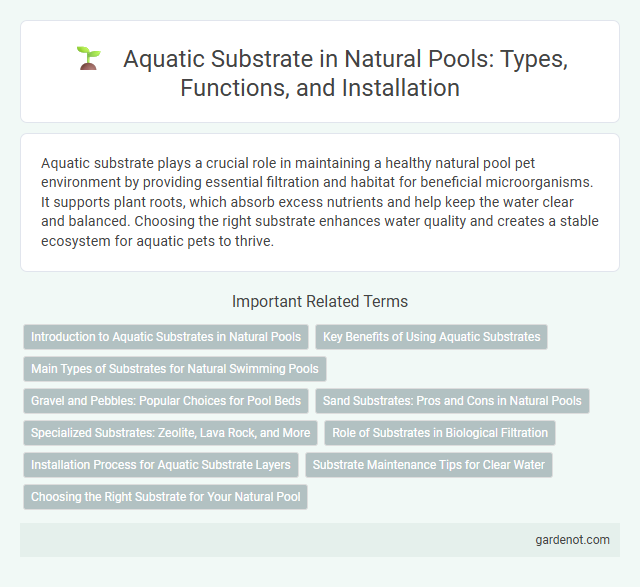Aquatic substrate plays a crucial role in maintaining a healthy natural pool pet environment by providing essential filtration and habitat for beneficial microorganisms. It supports plant roots, which absorb excess nutrients and help keep the water clear and balanced. Choosing the right substrate enhances water quality and creates a stable ecosystem for aquatic pets to thrive.
Introduction to Aquatic Substrates in Natural Pools
Aquatic substrates in natural pools serve as the foundation for biological filtration and habitat diversity, consisting primarily of gravel, sand, and organic matter tailored to support beneficial microorganisms and aquatic plants. These substrates enhance water clarity by promoting nutrient cycling and providing surfaces for biofilm formation, essential for maintaining balanced ecosystems without chemical additives. Selecting the appropriate substrate composition influences the overall health and self-sustainability of the natural pool environment.
Key Benefits of Using Aquatic Substrates
Aquatic substrates in natural pools provide essential filtration by supporting beneficial bacteria that break down organic waste, improving water clarity and quality. They promote a balanced ecosystem by supplying nutrients to aquatic plants, which stabilize the substrate and prevent algae overgrowth. This substrate also enhances habitat diversity, fostering a healthy environment for aquatic wildlife and maintaining overall pool sustainability.
Main Types of Substrates for Natural Swimming Pools
Aquatic substrates in natural swimming pools primarily consist of gravel, sand, and clay, each serving distinct ecological functions. Gravel facilitates water filtration and supports beneficial microbial life, while sand aids in nutrient absorption and maintains water clarity. Clay substrates help in stabilizing the pool bottom and promote the growth of aquatic plants essential for natural water purification.
Gravel and Pebbles: Popular Choices for Pool Beds
Gravel and pebbles are popular choices for aquatic substrates in natural pools due to their excellent filtration properties and aesthetic appeal. These materials promote water circulation, reduce debris accumulation, and provide a natural habitat for beneficial microorganisms essential for maintaining water quality. Their varied sizes and natural textures enhance the pool bed's stability while contributing to the overall ecological balance of the aquatic environment.
Sand Substrates: Pros and Cons in Natural Pools
Sand substrates in natural pools offer excellent filtration, providing a clean and clear aquatic environment while supporting beneficial microbial growth that enhances water quality. Their fine particles create a stable base for aquatic plants, aiding in nutrient absorption and preventing algae overgrowth. However, sand can compact over time, reducing oxygen flow to roots and requiring periodic maintenance to avoid stagnation and sediment buildup.
Specialized Substrates: Zeolite, Lava Rock, and More
Specialized substrates such as zeolite and lava rock play a crucial role in natural pools by enhancing water purification and promoting beneficial microbial activity. Zeolite's porous structure efficiently adsorbs ammonia and other harmful compounds, while lava rock provides an extensive surface area for biofilm growth, supporting natural filtration processes. Incorporating these substrates improves water clarity and maintains a balanced aquatic ecosystem without chemical treatments.
Role of Substrates in Biological Filtration
Aquatic substrates in natural pools serve as essential habitats for beneficial microorganisms that drive biological filtration by breaking down organic waste and harmful compounds. These substrates enhance water clarity and quality by supporting biofilm formation, which facilitates nutrient cycling and reduces pollutant levels. Choosing porous materials like gravel or lava rock optimizes surface area for microbial colonization, boosting the efficiency of the natural filtration process.
Installation Process for Aquatic Substrate Layers
The installation process for aquatic substrate layers in a natural pool begins with thorough site preparation, ensuring proper shaping and leveling of the pool bed to support effective water filtration. Layers of gravel, sand, and activated charcoal are carefully calibrated and placed to promote nutrient absorption, microbial activity, and root anchoring for aquatic plants. Proper compaction and grading of these substrates enhance water clarity and facilitate the biological filtration essential for maintaining a balanced aquatic ecosystem.
Substrate Maintenance Tips for Clear Water
Regularly removing organic debris from the aquatic substrate prevents nutrient buildup that can cloud water and promote algae growth. Using a gentle vacuum specifically designed for natural pools helps maintain substrate integrity without disturbing beneficial microorganisms. Periodic substrate aeration enhances oxygen flow, supporting healthy microbial activity essential for water clarity.
Choosing the Right Substrate for Your Natural Pool
Selecting the ideal aquatic substrate for your natural pool involves considering materials that promote beneficial microbial activity and support plant root systems, such as gravel or coarse sand. A well-chosen substrate enhances water filtration, stability, and clarity by facilitating nutrient cycling and preventing sediment suspension. Ensuring the substrate is free from contaminants and compatible with native aquatic plants is essential for maintaining a balanced and healthy ecosystem.
Aquatic substrate Infographic

 gardenot.com
gardenot.com